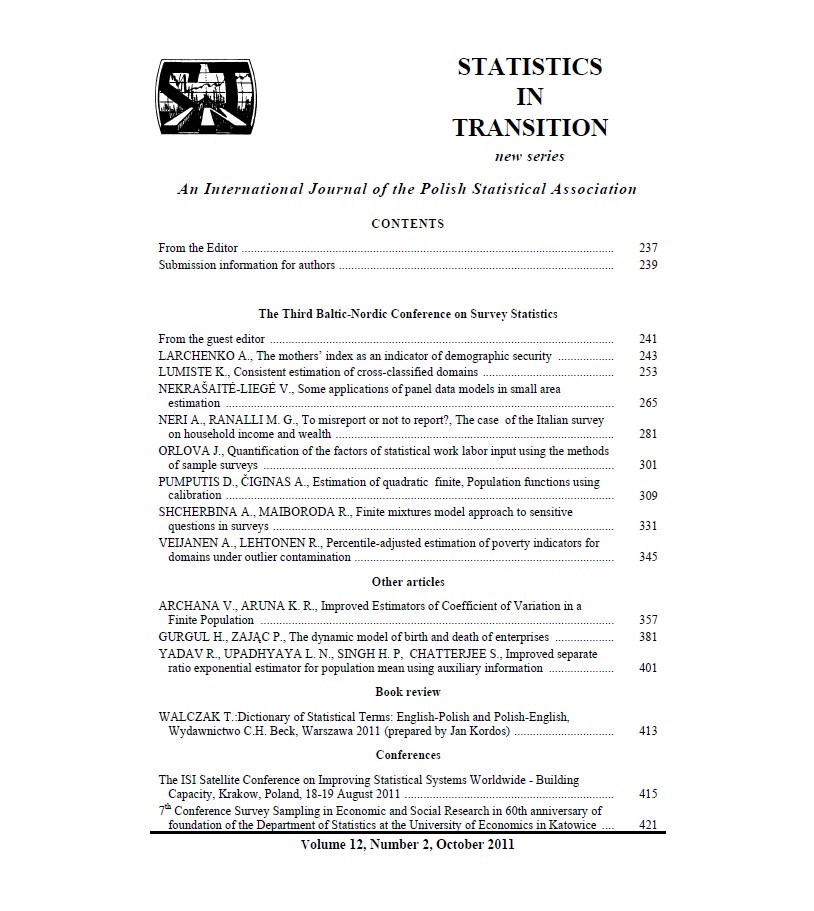ARTICLE
ABSTRACT
This study uses a real population from Statistics Lithuania to investigate the performance of different types of estimation strategies. The estimation strategy is a combination of sampling design and estimation design. The sampling designs include equal probability design (SRS) and unequal probability designs (stratified SRS and model-based sampling designs). Design-based direct Horvitz-Thompson, indirect model-assisted GREG estimator and indirect model-based estimator are used to estimate the totals in small area estimation. The underlying panel-type models (linear fixed-effects type or linear random-effects type) are examined in both stages of estimation strategies: sample design and construction of estimators.
KEYWORDS
Small area estimation; panel-type data; model-based; model-assisted
REFERENCES
HORVITZ, D. G. AND THOMPSON, D. J., (1952). A generalization of sampling without eplacement from a finite universe, Journal of the American Statistical Association, 47:663–685.
HSIAO, C. (2003). Analysis of Panel Data, Economic Society monographs no. 34, 2nd edition, New York: Cambridge University Press.
LEHTONEN, R. AND VEIJANEN, A. (2009). Design-based methods of estimation for domains and small areas. Chapter 31 in C.R. Rao and D. Pfeffermann (Eds.) Handbook of Statistics, Vol 29B, Sample Surveys: Inference and Analysis. New York: Elsevier.
LEHTONEN, R., SÄRNDAL, C.-E. AND VEIJANEN, A. (2003). The effect of model choice in estimation for domains, including small domains, Survey Methodology 29:33-44.
LEHTONEN, R., SÄRNDAL, C.-E. AND VEIJANEN, A. (2005). Does the model matter? Comparing model-assisted and model-dependent estimators of class frequencies for domains, Statistics in Transition 7:649-673.
NARAIN, R. D., (1951). On sampling without replacement with varying probabilities, Journal of the Indian Society of AgriculturalStatistics, 3:169–174.
NEDYALKOVA, D., TILLE, Y., (2008). Optimal sampling and estimation strategies under the linear model, Biometrika 95[3]:521-537.
NEKRAŠAITE-LIEGE, V., RADAVIČIUS, M. and RUDYS, T. (2011). Model based design in small area estimation. Lithuanian Mathematical Journal. 51[3]:417-424.
OMRANI, H., GERBER, P. AND BOUSCH. P (2009). Model-Based Small Area Estimation with application to unemployment estimates, World Academy of Science, Engineering and Technology 49, 793-800
RAO, J. N. K. (2003). Small Area Estimation. Wiley, New York. Rao, J.N.K. (2005). Inferential issues in small area estimation: some new developments. Statistics in Transition, 7, 513-526.
ROYALL, R. M., (1970). On finite population sampling theory under certain linear regression models Biometrika 57[2]:377-387.
SAEI, A. and CHAMBERS, R. (2003). Small Area Estimation under Linear and Generalized Linear Mixed Models with Time and Area Effects. Methodology Working Paper No. M03/15. University of Southampton, UK.
SÄRNDAL, C.-E., SWENSSON, B. and WRETMAN, J. (1992). Model Assisted Survey Sampling, Springer - Verlag, New York.
SINGH, M.P., GAMBINO, J. and MANTEL, H.J. (1994). Issues and strategies for small area data. Survey Methodology, 20, 314.
U.S. OFFICE OF MANAGEMENT AND BUDGET (1993). Indirect Estimators in Federal Programs, Statistical Policy Worlang Paper 21, NATIONAL Technical Information Service, Springfield, Virginia.
